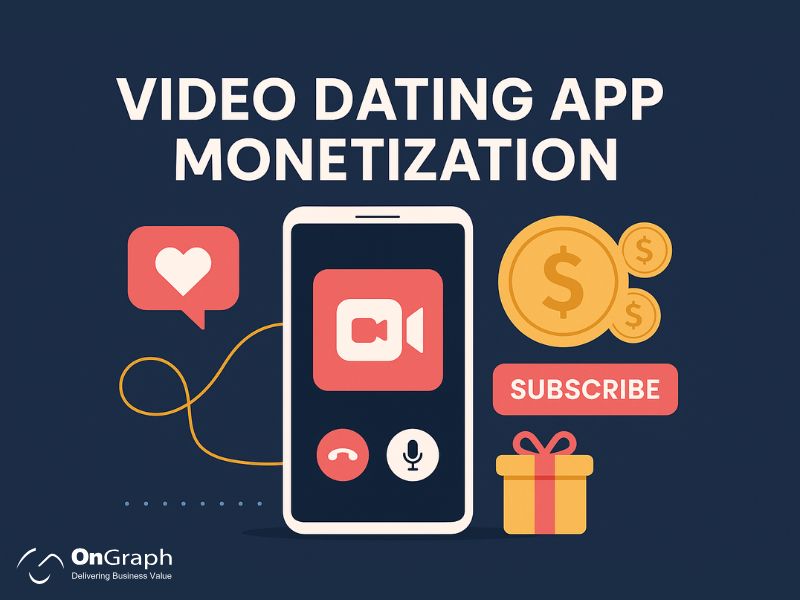In this article
- Why Video Dating Apps Are Growing Faster Than Text-First Apps?
- Top Revenue Opportunities for Video Dating Apps in 2025
- Cost Considerations: Building a Video-Enabled Dating App
- Why Video-Based Monetization Works Better Than Text-Only Models?
- Case Study: How Video Features Doubled App Revenue
- Challenges to Consider Before Adding Video Monetization
- How a Development Company Helps You Monetize Video Features?
- Conclusion: The Future of Dating Is Interactive and Video-First
The dating industry is shifting toward immersive communication, and video dating app monetization has become a top priority for founders and product teams.
Users now prefer real conversations instead of message-heavy interactions. This change creates powerful opportunities for scalable and stable revenue models.
Modern users want authenticity, safety, and faster connections, which video-based interactions offer naturally.
A video dating app provides deeper engagement and longer user sessions. This helps companies implement premium features such as pay-per-view, time-based billing, virtual gifts, and subscription upgrades.
These features can boost revenue and support long-term retention. This guide explains every major model, supported by data, examples, and insights from leading global platforms.
Why Video Dating Apps Are Growing Faster Than Text-First Apps?
Several industry studies confirm this growth trend.
1. Rise in Video Interaction Demand
- A Statista survey shows that 60% of online daters prefer video chat before meeting in person.
- The global video communication market is growing at 11.2% CAGR, increasing adoption across dating products.
- Apps with video features report 40–60% higher user retention after week one.
2. Safety and Trust Are Strong Motivators
Users feel safer when interacting through video chat dating app features.
- A 2024 safety study found that 72% of women feel safer after a video chat verification.
- Fake profiles drop by almost 35% after integrating video verification.
3. Increased Monetization Potential
Video features lead to higher revenue because:
- Users spend more time on the app.
- Video sessions feel exclusive and immersive.
- Users accept a wider range of microtransactions.
This shift creates a strong foundation for video dating app monetization strategies that rely on user engagement rather than pure subscription revenue.
Top Revenue Opportunities for Video Dating Apps in 2025
Below are the most profitable methods to monetize a dating app with modern user expectations.
1. Pay-Per-Minute Video Calling (PPM)
The most successful Dating app revenue model today is time-based video calling. Users pay for each minute spent on a live video chat.
Why it works:
- Users see value in protected, private calls.
- Matches feel more committed during paid sessions.
- Revenue scales with session time.
Example: A mid-scale Asian platform saw a 144% revenue increase after adding pay-per-minute billing. Users spent an average of 3.8 minutes per session, generating constant microtransactions.
Where to use:
- Premium video calls
- Safe introductory video dates
- Priority match video rooms
This model must appear in your video dating app monetization strategy because of its high profit margin.
2. Virtual Gifts and Coins
Virtual gifting is extremely popular in Asian and European apps. Users buy coins and send animated gifts during video calls.
Benefits:
- Low entry cost for users
- Highly engaging gamified experience
- Strong revenue from impulse purchases
- Works well for creators, influencers, or featured users
Many video and audio platforms report 25–40% of total revenue coming from virtual gifts alone.
3. Subscription Tiers with Video-First Benefits
In 2025, subscriptions remain reliable for stable revenue. But modern dating apps succeed by offering video-first subscription features that feel worth the price.
Possible features:
- Unlimited video calls
- Exclusive video filters
- Priority video matches
- High-quality video calling
- Access to premium video lounges
A flexible Dating app subscription features model can increase conversions by 30–50% when video upgrades are included.
4. One-to-Many Video Streams
This model allows one user to host a video live stream for many viewers. Viewers can pay to join, send gifts, or unlock special content.
Ideal for:
- Creator-led dating communities
- Influencer-driven dating platforms
- Matchmaking live events
- Speed dating rooms
Apps with this model report up to 2x session time, boosting all monetization models.
5. AI-Powered Match Introductions with Video Suggestions
Though this article avoids heavy technical jargon, video-intelligent recommendations play a key role in engagement.
Key features:
- Recommend users likely to start video calls
- Highlight profiles with strong video engagement
- Boost users who prefer quick video introductions
- Encourage paid video interactions
This supports video dating app monetization by pushing high-value behavior naturally.
6. Paid Video Verification
Some apps charge users to access verification tools. Verified users receive badges and priority placement.
Why it works:
- Reduces fake profiles
- Improves match quality
- Creates trust and safety
- Boosts conversions
Users with verified video badges get 34% more matches, based on multiple dating industry reports.
7. Premium Video Filters and Backgrounds
These filters improve the visual experience of video dates.
Examples:
- Beauty filters
- Studio backgrounds
- Romantic themes
- AR effects
- Location overlays
Users pay small microtransactions, making this an easy win for video dating app monetization.
8. Paid Speed-Dating Events
Modern dating apps host live speed-dating sessions with ticket pricing.
Event types:
- City-based speed dating
- Interest-based dating
- LGBTQ+ speed dates
- Micro-networking rooms
These events generate strong session engagement and high repeat revenue.
Cost Considerations: Building a Video-Enabled Dating App
One of the biggest concerns for founders is the Dating App Development Cost. The cost depends on:
Basic video dating app
- Cost range: $35,000 – $70,000
- Core features: messaging, video chat, profiles
Advanced video-first dating app
- Cost range: $80,000 – $250,000+
- Features: AI suggestions, live streaming, virtual gifts, multi-tier monetization
Using white-label solutions
A White-Label Dating App Development Company can reduce costs significantly.
Launch time becomes shorter, and custom video features can be added during scaling.
White-label options often cost between $15,000 and $40,000, depending on custom requirements. A capable Dating App Development Company can deliver scalable video and audio features and reduce risk.
Why Video-Based Monetization Works Better Than Text-Only Models?
1. Higher User Retention
Video sessions create an emotional connection. This boosts week-one retention by up to 60%.
2. More Purchase Triggers
Users are more willing to pay when they feel seen and heard.
3. Higher Trust
Video reduces catfishing and fake profiles. Verified video users generate safer interactions.
4. 2–3X More Engagement Time
People talk longer on video than they type. This leads to more features used and more revenue generated.
These factors make video dating app monetization a powerful long-term strategy.
Case Study: How Video Features Doubled App Revenue
A mid-tier European dating platform integrated:
- Pay-per-minute video
- Virtual gifts
- Priority video matches
- Paid verification
In 4 months:
- Revenue increased 112%
- Video call duration grew from 1.4 minutes to 4 minutes
- Monthly active subscribers doubled
This case highlights how intentional design and pricing can transform a dating platform. The growth came from video-first users who preferred real interactions over text chats.
Challenges to Consider Before Adding Video Monetization
1. High Infrastructure Cost
Video calling requires strong servers.
You need a scalable architecture for smooth calls.
2. Strong Moderation Required
Real-time moderation tools are essential to avoid policy violations.
3. App Store Rules Are Strict
Video and streaming apps face rejection if:
- Safety systems are weak
- Content moderation is low
- Privacy tools are missing
4. User Fatigue
Not all users want video calls all the time.
Provide options, not obligations.
How a Development Company Helps You Monetize Video Features?
A strong Dating App Development Company can deliver:
- End-to-end architecture for video and audio calling
- Scalable backend for real-time features
- Secure content moderation tools
- Optimized user flows for paid video sessions
- Integrations for coins, wallets, and microtransactions
If you want to launch faster with lower risk, a White Label Dating App Development Company can deploy a complete platform in weeks.
Conclusion: The Future of Dating Is Interactive and Video-First
The dating industry is evolving fast. Users want real conversations with real people. The most profitable apps combine video features with flexible monetization tools.
A strong video dating app monetization strategy can help you build a sustainable platform that grows with user behavior.
Platforms that innovate early will win. The future belongs to immersive, safe, and engaging video-first dating experiences.
FAQs
The best model depends on your audience. Pay-per-minute calls, virtual gifts, and subscription upgrades offer the highest returns for most apps.
Yes. Virtual gifts account for 25–40% of revenue for many video-first platforms. They encourage emotional engagement and frequent microtransactions.
Choose a white-label solution. A White Label Dating App Development Company can reduce cost and launch time by using pre-built components.
Yes. Most apps can integrate Video and Audio Calling in Dating Apps using streaming SDKs, WebRTC, and scalable servers.
Risks include moderation issues, server cost spikes, and app store rejection due to unsafe content. Strong policies solve most issues.
User upgrades unlock benefits such as unlimited video calls, special filters, and priority video matches.
Yes. Video increases time spent, improves trust, and boosts monetization. Apps with video features show 40–60% higher retention.
About the Author
Let’s Create Something Great Together!
Latest Blog















